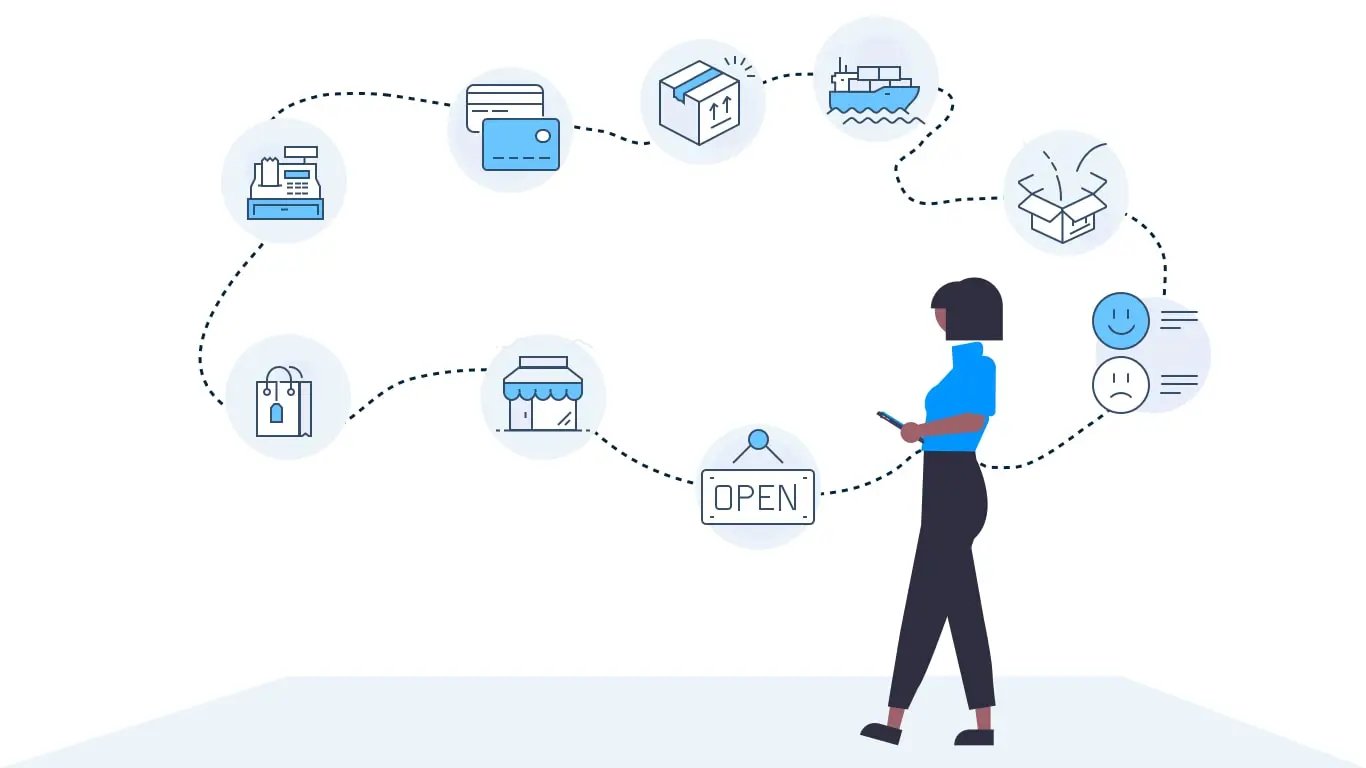
Increasingly, businesses are putting greater focus on customer experience management. But how can you tell if your efforts are working?
By measuring them.
Because you can't manage your efforts if you don't measure them.
Organizations often rely solely on anecdotal evidence to measure customer experience. However, taking a systematic approach, with a balance of quantitative and qualitative data, will provide more comprehensive insight.
You’ll gain visibility into what’s going on with your customers’ satisfaction, loyalty, and overall perception.
In this blog, we'll explore key metrics like Net Promoter Score (NPS), Customer Satisfaction Score (CSAT), and Customer Effort Score (CES). Plus, we'll dive into the art of collecting and analyzing customer feedback, mapping the customer journey, and measuring experiences on digital channels.
What Are Customer Experience Metrics?
Customer experience metrics are statistics used to measure satisfaction, loyalty, and overall customer perception.
Tracking these metrics can help you:
- understand customer sentiment,
- identify areas for improvement,
- and uncover growth opportunities.
Did you know that 73% of people consider customer experience an important factor when making a purchase?
CX metrics help you measure the effectiveness of your organization's customer experience efforts.
Continuously measuring customer experiences allows businesses to identify areas for improvement, build strong customer relationships, and ultimately drive long-term growth.
Key Customer Experience Metrics
Businesses have a range of customer experience metrics to choose from.
Three fundamental metrics worth exploring are:
1. Net Promoter Score (NPS)
%20metric.webp?width=1366&height=768&name=Net%20promoter%20score%20(NPS)%20metric.webp)
What is NPS, and how does it work?
Imagine you’re a hotel manager. Knowing if your customers would recommend your hotel to friends and family is valuable information. Using NPS, you can measure your customer’s loyalty and advocacy.
On a scale of 0-10, you can ask customers if they would recommend your business to others.
Then, categorize your customers into:
- Promoters (9-10): These are loyal customers who are likely to recommend your business enthusiastically.
- Passives (7-8): These customers are satisfied but not overly enthusiastic. They are neutral and can easily be swayed by competitors.
- Detractors (0-6): These customers are unhappy and may actively discourage others from engaging with your business.
Calculating NPS and interpreting the results
NPS is calculated by the total % of promoters minus the total % of detractors. The resulting score can range from -100 to +100.
- A positive NPS: indicates that you have more Promoters than Detractors, reflecting healthy customer loyalty.
- A negative NPS: signals that your business has more dissatisfied customers than enthusiastic ones. This needs your attention.
Weighted Net Promoter Score
You should use the Net Promoter Score (NPS) when you want a simple and straightforward metric for measuring your overall customer base. However, the results don’t always provide a complete picture.
If you want to give more importance to a certain segment of customers, like your high-value clients, then you should opt for a weighted NPS.
Weighted NPS = (% Promoters × Weight for Promoters) - (% Detractors × Weight for Detractors)
According to the 80/20 rule, 80% of a business's value is generated by 20% of its customers. Placing a greater emphasis on the feedback of your most significant customers ensures their feedback carries more weight for this metric.
Best practices for using NPS as a customer experience metric
Obtaining NPS scores is just the start.
The real value lies in understanding the reasons behind the scores and taking meaningful action.
Review this metric over a specific period of time, like a quarter, six months or year to year. This will help you keep a pulse on customer sentiment.
Remember, the goal is not just to have a high NPS but to turn Detractors into Promoters. This is especially important for high-value customers. You need to work on the problems and get them resolved quickly.
2. Customer Satisfaction Score (CSAT)
%20metric.webp?width=1366&height=768&name=Customer%20satisfaction%20score%20(CSAT)%20metric.webp)
Understanding CSAT and its significance
Imagine you created a project management platform. Every user has a unique experience navigating your platform's features and functionalities.
CSAT measures this range of experiences by asking customers to rate their satisfaction on a scale.
CSAT Score (%) = (Number of Satisfied Customers / Total Number of Respondents) * 100
Implementing CSAT surveys and analyzing the results
If you want to leverage CSAT effectively, ensure your surveys are timely and targeted.
Suppose a user has just accomplished a task or used a feature on your project management platform. At that moment, a short CSAT survey pops up and asks them to rate their satisfaction.
This approach ensures timely and targeted feedback. By understanding user sentiment accurately, you can fine-tune the platform.
After collecting the CSAT scores, you can analyze the results to identify common themes and pain points and make improvements
Review and assess CSAT consistently. By making adjustments, you can ensure that metrics like your net promoter score aren't affected.
Tips for improving CSAT scores
You can improve CSAT scores by doing the following:
- Enhance Communication Channels: Give customers various ways to reach out, including phone, email, chat and social media. Contact center solutions can help you manage customer interactions through multiple channels.
- Consistency Across Channels: Make sure the customer experience is consistent across all channels. Whether your customer is reaching out by phone, social media, email or in person, the experience should be consistent. Using an omnichannel contact center can ensure this level of consistency.
- Empower Customer-Facing Teams: Train support teams to respond to inquiries more effectively. Equip them with product knowledge and ensure they remain customer-focused.
- Personalize Interactions: Use customer data and history to give personalized recommendations.
- Proactive Issue Resolution: Anticipate problems and proactively address them. Keep customers informed of potential disruptions and delays.
- Efficient Self-Service: Provide easy-to-use self-service options like FAQs, knowledge bases, or interactive chatbots.
Related: What Is An Omnichannel Contact Center?
3. Customer Effort Score (CES)
%20metric.webp?width=1366&height=768&name=Customer%20Effort%20Score%20(CES)%20metric.webp)
Understanding CES and its purpose
CES measures how hard your customers have to work to resolve issues or accomplish tasks.
Suppose a customer calls an organization for assistance. They go through multiple call transfers and long wait times. Customer effort would be considered high in this case. It would likely lead to frustration, dissatisfaction and impact their overall experience with the company.
Customer effort is everything. It drives experience, brand perception and overall satisfaction.
Related: How To Improve Customer Experience In A Contact Center
Measuring customer effort
A simple CES question could be, "On a scale of 1 to 5, how much effort did you have to put forth to resolve your issue?".
The scale usually ranges from "Very Easy" to "Very Difficult." The calculation involves averaging the responses and can be presented as a numerical score or a percentage.
CES = (Sum of Individual Responses) / (Total Number of Responses)
Leveraging CES to enhance customer satisfaction
By identifying and addressing high-effort areas, businesses can simplify the process. This not only boosts customer satisfaction but also helps reduce operational costs and enhance customer loyalty.
Additional Customer Experience Metrics
Customer Retention Rate (CRR)
- What it is: The Customer Retention Rate measures the percentage of customers the company keeps over a specific time period.
- Why it's important: High retention indicates customer satisfaction and loyalty. It also reducing the need to constantly acquire new customers.
- How to measure CRR: (Customers at the start of the period - Customers acquired during the period) / Customers at the start of the period * 100.
Customer Churn Rate
- What it is: The Customer Churn Rate represents the percentage of customers who stop using a product or service within a given timeframe.
- Why it's important: High churn suggests dissatisfaction or lack of value, impacting revenue and growth.
- How to measure: Customers lost during the period / Customers at the start of the period * 100.
First Contact Resolution (FCR)
- What it is: FCR measures the percentage of customer inquiries or issues resolved during initial contact with customer support.
- Why it's important: It will help you assess the efficiency of your support team and the quality of customer interactions. High FCR represents positive experiences.
- How to measure: (Number of issues resolved on first contact) / (Total number of customer issues) * 100.
Average Resolution Time (ART)
- What it is: ART is the average time it takes to resolve customer issues or inquiries by customer support.
- Why it's important: Shorter ART indicates responsiveness and effectiveness of your customer support processes.
- How to measure: Total time taken to resolve issues / Number of resolved issues.
Customer Referral Rate(CRR)
- What it is: CRR measures the percentage of customers who refer others to use a product or service.
- Why it's important: High referral rates demonstrate customer satisfaction. Use it to understand how satisfied your customers are and if they will recommend your product.
- How to measure: (Number of referrals) / (Total number of customers) * 100.
Monthly Active Users (MAU)
- What it is: MAU is the number of unique users who interact with a product or service within a month.
- Why it's important: Use MAU to assess user engagement and the ongoing relevance of your product.
- How to measure: Count of unique users who accessed the product in a given month.
Trial-to-paid Conversion Rate
- What it is: Trial-to-paid Conversion Rate measures the percentage of trial users who become paying customers.
- Why it's important: Use it to track the effectiveness of your trials, and the success of converting users into customers.
- How to measure: (Number of trial users who convert to paid) / (Total number of trial users) * 100.
Collecting Customer Feedback

Customer feedback reveals customer preferences, pain points, and desires. This feedback forms the foundation for data-driven decisions. And gaining feedback from high value clients is critical, to ensure their satisfaction.
Different Methods For Collecting Customer Feedback
Some of the most effective methods to gather customer feedback include
- Surveys: Conduct targeted surveys to identify customer preferences, satisfaction, and expectations. Well-structured survey questions have higher response rates.
- Interviews and Focus Groups: Get qualitative insights into your customer's experiences, opinions, and emotions through face-to-face interactions.
- Social Media Monitoring: Monitoring platforms makes it possible to track brand mentions, sentiment, and emerging trends.
- Online Reviews and Ratings: Identify common issues and gauge overall satisfaction by monitoring online reviews. Review sites include G2, Google Reviews, Trustpilot.
- Sentiment Analysis: Sentiment analysis provides immediate feedback on how customers feel during interactions. Without having to reach out for feedback, you can gauge the happiness of your callers. Following this, you can reach out to the ones that seemed unhappy, or ones that seemed willing to go ahead.
Best Practices For Collecting Customer Feedback
- Choose the right communication channel: If customers are reaching out to you via SMS, WhatsApp or email, collect feedback using those same channels. Remember, it’s all about meeting customers where they are.
- Use third parties: You can also have external organization conduct outbound survey campaigns.
- Empower Agents to Share Feedback: It’s important to empower agents to share feedback with their leadership team. Often, agents don’t want to report problems because it’ll impact their score. Foster a culture where feedback benefits the entire organization, including the agents themselves.
Analyzing Customer Feedback

Organize and categorize customer feedback
You might have feedback from various sources, start by centralizing this feedback. Use tags to categorize feedback based on topics, features or sentiments. This makes retrieving and analyzing data easier.
Identify trends and patterns
Identify recurring keywords, phrases, and issues in your customer feedback. Analyze these patterns to pinpoint areas for improvement or optimization.
Using sentiment analysis for customer sentiment
Leverage sentiment analysis tools to classify feedback as positive, negative, or neutral. When you understand customer emotions, you can begin to address negative sentiments and reinforce positive experiences.
Apply text analytics for deeper insights
Text analytics can help you extract key information from unstructured feedback. Focus on critical keywords related to your product or service, such as ‘integrations’ or ‘security’. This will help to align your CX strategy with customer needs.
Related: What Is Customer Experience Management Strategy?
Customer Journey Mapping

Customer journeys begin when a customer discovers a brand and continues with each interaction past the sale.
Customer journey mapping involves visualizing each of these interactions and touchpoints.
By understanding the entire journey from start to finish, you can gain valuable insights into your customers' perspectives, needs, and emotions.
Mapping the customer journey
Start by creating a comprehensive map that captures each stage of the customer lifecycle. From initial awareness to post-purchase engagement. Your map can differ significantly depending on your industry and business.
Identify touchpoints and interactions
A touchpoint is when a customer interacts with your business. Interactions can occur on your website, in-store, via customer support channels and more. By identifying these touchpoints, you will be able to spot critical moments that impact customer experience.
Pinpoint pain points and areas for improvement
Consider the customer's perspective. Look at what channels they're engaging with and how they’re utilizing them. Customer journey mapping will help you pinpoint pain points in your processes and interactions. Maybe it's a lengthy checkout process or lackluster customer service. To ensure a smooth customer journey, you must address pain points immediately.
Using customer journey mapping to measure and enhance customer experience
If you identify any pain points, it's very important to address them right away. Identify opportunities for improvement, and align internal processes to meet customer needs. This will ease the sales process and set up future opportunities with the customer. You will be able to deliver a seamless experience that keeps customers coming back.
Metrics for Digital Channels
 In today's digital age, customers interact with businesses through various digital channels, including websites, social media, and mobile apps. Measuring customer experiences on these digital channels is key to staying competitive.
In today's digital age, customers interact with businesses through various digital channels, including websites, social media, and mobile apps. Measuring customer experiences on these digital channels is key to staying competitive.
Tracking website analytics
Your website acts as the hub of your digital presence. Monitoring website analytics provides businesses with critical data on user behavior, traffic patterns, and interactions.
Key website metrics include:
- Page Views: Shows how many visitors browsed your website. An increase in page views indicates growing interest and visibility.
- Bounce Rates: Indicates how many visitors left your website after viewing only one page. High bounce rates may indicate issues with content relevance or site performance.
- Conversion rates: Indicate how many visitors completed a desired action, such as making a purchase. Improving conversion rates can lead to increased revenue and customer engagement.
Analyzing user behavior through heatmaps and clickstream analysis
Have you ever wondered what your customers are really doing on your website? Heatmaps and clickstream analysis can help you find out.
- Heatmaps visually represent where users are clicking, scrolling, and lingering
- Clickstream analysis tracks the sequence of pages visited. Think of it like a GPS that tracks your customer’s digital journey. It’ll help you understand customer behavior and spot any roadblocks
Monitoring social media engagement
Social media platforms are full of existing and potential customers. Monitoring social media engagement involves tracking key metrics such as:
- Likes, shares, and comments that show customers' approval. Positive engagement signals a strong brand presence.
- Sentiment Analysis reveals attitudes expressed on social media. This can help businesses gauge their reputation and understand customer perceptions.
Measuring customer experience in mobile apps
You can measure the success of your mobile app by tracking downloads, ratings and reviews. Positive ratings boost reputation, while negative feedback points to areas needing improvement.
Linking Customer Experience Metrics to Business Goals

Align customer experience metrics with your overall business objectives
To achieve results, set meaningful benchmarks and align your CX metrics with your business goals.
For example, suppose you run a subscription-based streaming platform. One of your business goals is to increase customer retention. Focus on metrics like customer churn rate, customer lifetime value (CLV), and satisfaction with content selection. These metrics are more valuable than those that don’t directly measure retention.
Identifying relevant key performance indicators (KPIs)
Tracking your KPIs will help you prioritize efforts that are aligned with your business strategy. Don't get lost in a sea of metrics. Concentrate on the ones that directly impact your success.
Suppose you operate an e-commerce website. Important KPIs could include conversion rate, cart abandonment rate, and average order value. Metrics like these reveal your customers' buying behavior and help you improve the purchasing process.
Use customer experience metrics to drive improvements
Customer experience metrics are not just numbers on a chart. They are valuable tools for driving meaningful improvements.
Suppose you run a chain of boutique hotels, and your guests frequently mention the slow check-in process in their feedback. With this insight, you can implement strategies like mobile check-ins, self-service kiosks, or adding more staff during peak hours.
The Role of Customer Feedback in Business Decision-Making
Customer feedback contains a treasure trove of insights.
Incorporating customer feedback into decision-making is a powerful way to build customer-centric organizations.
You can use this feedback to:
- make informed decisions,
- prioritize improvements,
- adapt strategies to better serve customers.
Imagine, for instance, that a shoe brand consistently hears from customers about their uncomfortable shoe soles. In response, the brand invests in research and development to design more ergonomic and comfortable shoe soles. This not only boosts customer satisfaction but also improves the brand's reputation as a provider of comfortable footwear.
Best Practices For Measuring Customer Experience Metrics

To get the most value from your customer experience metrics, it's crucial to follow these best practices:
Ensure Data Accuracy and Reliability:
Validate data sources, eliminate errors, and maintain data integrity. Reliable metrics are essential for making informed decisions.
Implement a Regular Feedback Collection Process:
Create channels for customers to provide feedback regularly. Consistent feedback helps you stay attuned to your customers’ evolving needs.
Establish Benchmarks and Goals:
Set clear benchmarks and goals for each customer experience metric. Comparing performance against these benchmarks enables you to gauge progress effectively.
Incorporate Customer Feedback Into Employee Training and Development:
While not everyone has a customer facing role, everyone has a customer impacting role.
Use customer feedback and integrate it into training and development so team members understand their impact on customer satisfaction.
Continuously Monitor and Iterate on Customer Experience Initiatives:
Customer experience is an ongoing journey. Continuously monitor metrics, gather feedback, and adapt to changing customer preferences.
Tools and Technologies for Measuring Customer Experience Metrics

In today's data-driven world, various tools and technologies can help businesses effectively measure customer experience metrics. Let's explore some of the key tools that can provide valuable insights:
Customer survey platforms
Customer survey platforms are invaluable for gathering feedback directly from customers. Using these tools, businesses can create and distribute surveys. They can identify customer satisfaction, preferences, and pain points.
Social media monitoring tools
Social media monitoring tool tracks brand mentions, sentiment, and customer interactions. The ability to monitor conversations and identify trends in real-time helps businesses address customer concerns proactively.
Text analytics software
Text analytics software leverages natural language processing to analyze unstructured data. This includes customer reviews, feedback emails, and chat transcripts. This technology can extract insights from textual data.
Web analytics tools
Web analytics tools provide data on customer behavior across websites and digital platforms. These tools track customer journeys, measure conversion rates, and identify areas for website optimization
Final Thoughts + Recap
Measuring customer experience metrics and leveraging them effectively is a crucial part of developing a winning customer experience strategy.
Key Takeaways:
- Customer experience metrics, such as NPS, CSAT, and CES, are indispensable tools to gauge customer satisfaction, loyalty, and perception.
- Collecting and analyzing customer feedback is the backbone of data-driven decision-making. It enables you to make informed decisions based on your customers' views.
- Customer journey mapping allows you to visualize your customers' interactions and experiences.
- Measuring customer experience on digital channels is essential in today's digital world. It empowers you to stay competitive and meet customer expectations.
- Linking customer experience metrics to your business goals ensures a customer-centric approach, aligning your efforts with your organization's overall strategy.
- Use customer survey platforms, social media monitoring, text analytics, and web analytics to gain actionable insights and continuously improve.
By applying these insights and best practices, you'll have the ability to measure your CX efforts and create memorable experiences. Prepare to delight your customers and build unwavering loyalty.
To learn more about how you can shape better customer experiences and increase your customer satisfaction with net2phone, speak to one of our experts today!


%20metric.webp?width=1366&height=768&name=Net%20promoter%20score%20(NPS)%20metric.webp)
%20metric.webp?width=1366&height=768&name=Customer%20satisfaction%20score%20(CSAT)%20metric.webp)
%20metric.webp?width=1366&height=768&name=Customer%20Effort%20Score%20(CES)%20metric.webp)



 In today's digital age, customers interact with businesses through various digital channels, including websites, social media, and mobile apps. Measuring customer experiences on these digital channels is key to staying competitive.
In today's digital age, customers interact with businesses through various digital channels, including websites, social media, and mobile apps. Measuring customer experiences on these digital channels is key to staying competitive.

